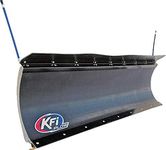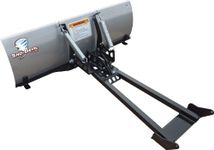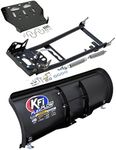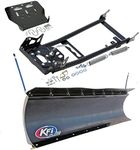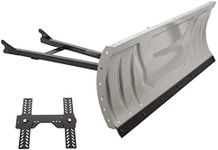Buying Guide for the Best Atv Plows
Choosing the right ATV plow can make a significant difference in how efficiently and effectively you can clear snow, dirt, or other debris. When selecting an ATV plow, it's important to consider several key specifications to ensure you get the best fit for your needs. Understanding these specs will help you make an informed decision and get the most out of your purchase.Plow WidthPlow width refers to the horizontal measurement of the plow blade. This spec is important because it determines how much area you can cover in a single pass. Plow widths typically range from 48 inches to 72 inches. A wider plow can clear more snow or debris quickly, but it may be harder to maneuver in tight spaces. If you have a large, open area to clear, a wider plow might be ideal. For smaller or more confined areas, a narrower plow would be more practical.
Blade MaterialThe blade material of an ATV plow can affect its durability and performance. Common materials include steel and polyethylene. Steel blades are very durable and can handle heavy-duty tasks, but they can be prone to rust and are heavier. Polyethylene blades are lighter and resistant to rust, making them easier to handle and maintain. However, they may not be as durable as steel for very tough jobs. Consider the type of work you'll be doing and the conditions you'll be working in when choosing the blade material.
Mounting SystemThe mounting system is how the plow attaches to your ATV. This spec is crucial because it affects the ease of installation and removal, as well as the stability of the plow during use. There are different types of mounting systems, such as front-mount and mid-mount. Front-mount systems are easier to install and remove, making them convenient for occasional use. Mid-mount systems offer better stability and are suitable for more frequent or heavy-duty use. Choose a mounting system that matches your usage frequency and the type of tasks you'll be performing.
Blade Angle AdjustmentBlade angle adjustment allows you to change the angle of the plow blade to direct the snow or debris to the side. This feature is important for efficient plowing, as it helps you control where the cleared material goes. Some plows offer manual angle adjustment, while others have hydraulic or electric systems for easier operation. If you need to frequently change the blade angle, a hydraulic or electric system can save you time and effort. For occasional use, a manual adjustment system may be sufficient.
Lift SystemThe lift system is how you raise and lower the plow blade. This spec is important for controlling the depth of the plow and for transporting the plow when not in use. Lift systems can be manual, winch-operated, or hydraulic. Manual lift systems are simple and cost-effective but require more physical effort. Winch-operated systems use an ATV winch to raise and lower the blade, offering a good balance of convenience and cost. Hydraulic lift systems provide the most ease of use and precision but are more complex and expensive. Consider how often you'll need to adjust the blade height and your preference for convenience when choosing a lift system.
